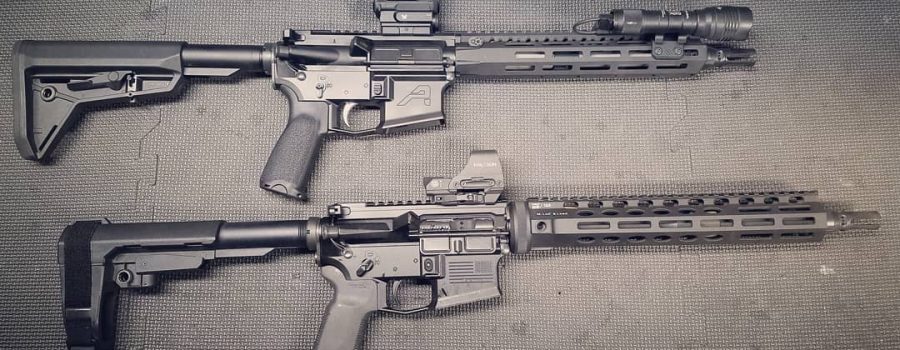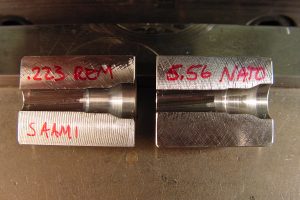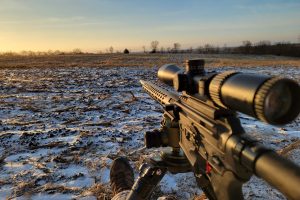“It depends,” and you’ll just have to decide for yourself in the end what is best for you. Like with so many other subjects, “it depends” applies here and is an answer that will require you to evaluate and analyze your requirements. But let’s delve a little deeper.
DISCLAIMER: The information on this website does not contain legal advice, and therefore it is not to be construed as legal advice. Every case is different, and this material is not a substitute for, and does not replace the advice or representation of, a licensed attorney.
This is a very common question with many facets and opinions. It is a topic that is heavily debated at length in social media groups, ranges, forums, and gun stores across our nation. Everyone seems to have an opinion on the topic, and evidenced by the number of times that I’ve seen and heard this debate arise, many people are looking for the answer.
Definitions Matter
As currently defined by as defined by 26 U.S.C. 5845(a)(4), an SBR (short barreled rifle) is a handgun or other weapon with an overall length of less than 26 inches, or a barrel or barrels of less than 16 inches in length is assembled or otherwise produced from a weapon originally assembled or produced only as a rifle, such a weapon is a “weapon made from a rifle”.

For purposes of measuring overall length when a folding or telescopic stock is attached, the measurement is taken from the crown of the barrel to the end of the buffer tube or folding stock when the stock is in the folded position. Detachable muzzle devices do not count toward an SBR’s overall length. If the muzzle device is pinned and welded, then the length would be measured from the end of the muzzle device to the end of the buffer tube.
On the contrary, pistols are firearms designed to be gripped by one hand. They can have any length barrel, though most commonly they will have shorter barrels ranging from 3 to 12 inches. While pistols cannot have a “stock” they can have a brace such as an arm brace, a stabilizing brace, or in some cases just a buffer tube with some padding or foam on the end.
Is it Legal to Shoulder a Pistol Brace?
As of this writing, the answer is, “Yes, it is completely legal to shoulder a firearm equipped with a pistol brace”. That answer has changed a few times over the years, most notably with a January 2015 Open Letter from the ATF that appeared to say it was illegal.
In 2019 a ruling clarified that it was legal to shoulder a braced pistol:
“To the extent the January 2015 Open Letter implied or has been construed to hold that incidental, sporadic, or situational ‘use’ of an arm-brace (in its original approved configuration) equipped firearm from a firing position at or near the shoulder was sufficient to constitute a ‘redesign,’ such interpretations are incorrect and not consistent with ATF’s interpretation of the statute or the manner in which it has historically been enforced.”
As with all things government, and especially the ATF, these bureaucratic rulings are always subject to change. As has happened on more than one occasion, they can be eliminated or reinterpreted overnight by the swift penned scribble of a non-elected department administrator or by an elected presidential administration.
Details Matter
At this point, you might be asking yourself why the rifle stock versus brace is a big deal? To some, it isn’t. For others, it is the difference between chocolate or vanilla. But yet for some it may mean being compliant with state laws, or a lot of additional paperwork and hassle when it comes time to decide between an SBR or AR pistol.
On pistols, you cannot have a vertical forward or forend grip (VFG). These are allowed on rifles, as the ATF defines a rifle as a weapon that is fired from the shoulder and generally requires two hands in order to shoot it.

As previously stated, pistols are defined as firearms that were designed primarily to be fired with one hand so a VFG will run afoul of the law in most cases. A pistol with an overall length of 26” or less and a sub 16” barrel would be considered an AOW (Any Other Weapon) with a VFG attached. Transfer of an AOW is the same as an SBR or machine gun, except the transfer tax is only $5. It is a $200 tax to make one, however.
This is probably one of the things that I see most overlooked at the range, as well as in gun groups and forums. Individuals will have an AR pistol build, but then have a vertical grip on it. They unknowingly violated law.
To add in yet another area of gray for grips, you have the angled fore grips which are currently allowed on pistols. While I’ve not experienced it, I have heard of individuals receiving stern warnings from “officials” that they needed to tread lightly due to the angle.
SBR’s, on the other hand, can use whatever grips you like.

SBR Bureaucratic Tape
One of the main arguments against SBR’s that I consistently encounter (and the reason that an SBR is not for me) is the amount of regulations and involvement with the federal government. While the NFA has been amended in the past, it is my belief that the NFA should be done away with as it is a Constitutional infringement. But, for the time being, if you want to stay in the legal realm, you have to comply with it.
All SBR’s must be approved by the ATF for initial manufacture and registration as well as every time the SBR changes ownership. This requires fingerprints, photos, and filling out either a Form 1 to manufacture or a Form 4 to transfer ownership.
The registration of an SBR requires payment of a $200 tax stamp with the NFA. This is a one-time tax per owner and it is not an annual fee. The tax must be paid every time the SBR transfers to a new owner. In the AR pistol vs. SBR debate, this is the pistol’s primary advantage. The application approival process can take from 2 months to a year, or more.

It doesn’t end there though. If you are to possess an NFA item(s) then it is in your best interest to have them in a Trust. This is an extra cost and of course more paperwork. The SBR will also require that receiver be engraved with the Trust and/or new serial number.
If you have an SBR and need to travel out of the state you manufactured it in, you have to seek permission from the ATF to take it across state lines. This requires completion of a Form 20 with the ATF. The ATF Form 20 has to be filled out and sent in for approval before you can legally transport your SBR to another state (assuming SBR’s are legal there). The good news is that they are almost always automatically approved, are free of charge and they can be filled out 1 year in advance.
Pistols do not require the Form 20 permission, which is a huge draw for some people.
Know the Local Laws
Each state is going to have a different stance on SBR’s and pistol builds. Worse yet, is that a lot of law enforcement officers simply do not know a ton about the differences between SBR’s and pistol builds. Or the laws that accompany each, while others still aren’t informed on tax stamp laws. So your best bet is to make sure you know them well enough to explain.
It should be known, but it is still worth noting that state laws will vary. With the exception of Hawaii, New York, New Jersey, Rhode Island, and the District of Columbia; SBR’s are generally legal to possess in the remaining 46 states. In the case of California, this can only be done with Curio & Relic (C&R) firearms and in Illinois, the owner has to have a C&R Federal Firearms license or other FFL. An AR pistol is not always an option in these states, either. Check the state and local laws before deciding on either one. And while we are talking about traveling with a firearm, know the law as it pertains to ammunition for the states that you will be in. For example, there are still states where hollow point bullets are illegal. This applies to all firearms.

If you aren’t sure of your state’s laws or the laws of states that you will be traveling in, contacting the state’s Department of Public Safety or a local ATF field office can get you the answers you need.
Currently, here in Iowa a person with an Iowa carry permit can transport a loaded handgun or long gun in their vehicle. The same applies to the respective AR’s.
Some Live in the Gray Area
As previously mentioned rifles are designed for shouldered fire, while pistols are not. As times change and parts and accessories evolve, so do the uses and applications that shooters come up with.
Pistol Stabilizing Braces is one of those topics that has evolved, changed, and remains left in the dark. Recently braces came to the forefront again with the Q LLC incident concerning the Honey Badger. That almost made thousands of Q Honey Badger owner’s felons overnight. For now, the ATF has withdrawn from that fight. But have they? Maybe it was just a calculated retreat for now, only to regroup and come back stronger.
Regardless, the ATF has responded to this topic over and over, repeatedly saying that shouldering a brace (as of this writing) is not illegal. See the ATF Letter. That isn’t to say that it is entirely legal either though, as there have been court cases where ATF letters were not allowed to be admitted as evidence. If you plan to use a determination letter at any point, your best bet is to write to the ATF and get one addressed to you specifically.

In the future this could very well change, so make sure you stay aware of the current status so you aren’t caught off guard.
SBR’s on the other hand, even with all of their requirements, offer a level of legal protection. In the states that allow them, as long as you have the tax stamp and documentation to prove it, you are good to go.
With an SBR you can shoulder your gun or fire without shouldering, have your barrel and overall length as short as you like, or use whatever furniture you like. You can also rest easy knowing that you have something more solid than a determination letter to rely on if you are confronted about your firearm.
Which One’s Better for Me?
“It depends”. As far as SBR vs. a pistol, what may be the best for one person may not be the best for another. Every shooter has goals with regard to their firearms. As previously mentioned, state laws must also be taken into consideration. In the case of trying to determine whether to buy an AR pistol vs. an SBR, you need to evaluate why you need one more than the other or which one makes more sense to you as a firearms owner.

The primary benefit of owning an SBR is to make a more compact rifle. Many shooters who run silencers or suppressors find the rifle can become unwieldy or lengthy when attached to a barrel in excess of 16”.
An SBR also gives the shooter the benefit of using a dedicated stock as opposed to a brace. Let’s face it; even the best brace will not give a shooter the comfort and stability of a proper rifle stock.
As already mentioned, the biggest downside to an SBR is the NFA requirement and, as mentioned, taking an SBR across state lines. While the tax is not a huge financial burden and the wait time is a matter of patience, some shooters are not allowed to own them in the states in which they live due to an unconstitutional ban at the state level or the requirements of additional paperwork or licensing.
Another disadvantage, particularly if you rely on your SBR for self-defense is that many states, counties, and cities restrict transporting a loaded rifle. That is defined as with a round in the chamber.
Perhaps the biggest benefit of an AR Pistol over a dedicated SBR is that there is no NFA paperwork or taxes. Is a rifle with a barrel that is 15.5” as opposed to 16” worth paying a $200 tax and having all of the restrictions placed upon it?

Unlike an SBR, in most places an AR pistol can be transported in a loaded condition with a round in the chamber and can be taken across state lines without a permission slip, unless the other state has prohibitions against AR pistols.
The biggest drawback of owning an AR pistol can be the configuration of the brace and the murkiness of rulings regarding shouldering a braced pistol. The other would seem to be the ATF declaring braces as stocks on a whim as has happened to a number of manufacturers.
As opposed to SBR’s, pistol braces do not count toward overall length as they are deemed an accessory. This falls into the realm of using a pistol with a VFG. If the firearm has a shorter than 16” barrel and no stock and exceeds 26” in overall length it is considered a firearm by federal definition vs. a pistol or handgun and a VFG is allowed.
Lastly, an AR pistol can look a lot like an SBR to an uninformed police officer and a shooter could run into a hassle while shooting or even at a traffic stop. You may be completely legal and correct, which is why it is good to be educated in these laws and statutes. It is probably not a bad idea to carry the ATF approval letter for the manufacturer’s brace, either. It may, or may not provide useful but it is yet another tool.
Parting Shots
To some people, SBR’s are only for people wanting to play operator. To others, AR pistols are for “The Poors” or whom are paranoid to get the tax stamp.
In the end, the person that can make the decision on which is better is you. Laws, regulations, and each person’s needs and application are going to be different. Where you live, your budget, and at some point, your patience will all come into play when deciding which is better.
BRD Gun Works~ Performance you can afford when you can’t afford failure



